Blue is an attention-grabbing color associated with the sky and open spaces and symbolizes freedom, intuition, imagination, inspiration, and sensitivity. White color represents purity, innocence, and perfection.
That’s why seeing a blue and white bird can instantly brighten your day.
The list of blue and white birds includes the mountain bluebird, blue jay, blue-gray tanager, blue and white kingfisher, collared kingfisher, tree swallow, blue-and-white flycatcher, and many many others.
Let’s explore the 20+ most interesting birds that have the blue and white color of their plumage so you can identify them the next time you meet them in the wild.
Table of Contents
Blue And White Birds
Mountain Bluebird
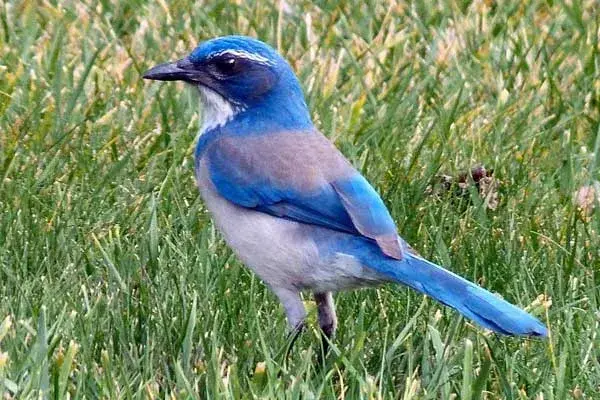
Scientific name: Sialia currucoides
Lifespan: 6-9 years
Wingspan: 14 in
Plumage Color: Sky-blue with white under the tail
Native to: Western North America
The mountain bluebird is a small migratory thrush with a round head and a straight, thin beak. It can be found in mountainous districts of western North America.
It is a beautiful bird that is easy to identify by the vivid bright sky-blue plumage in males. The wings and tail have a bit darker blue color while the part under the tail is white.
This blue and white bird is the state bird of Idaho and Nevada.
The mountain bluebird is an omnivore that mostly feeds on spiders, grasshoppers, flies, other insects, and small fruits.
Mountain bluebird has a population of around 4.6 million.
It is a secondary cavity nester – it builds its nest inside old woodpecker holes or naturally occurring holes in trees. Males are the ones that look for nests while the females make the final decision. That’s because the females are the ones that build the nest.
They are one example on our list of 20+ birds that have blue wings.
Blue Jay
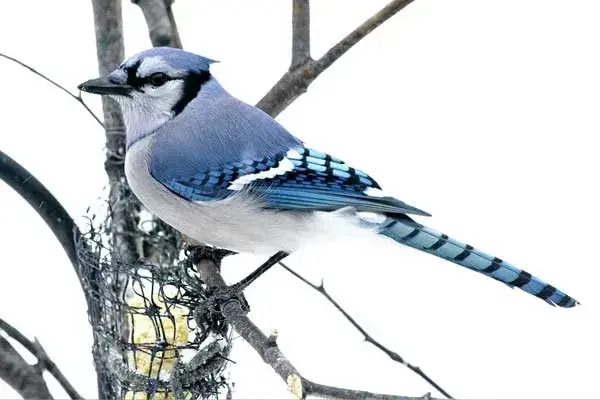
Scientific name: Cyanocitta cristata
Lifespan: 7 years
Wingspan: 13-17 in
Plumage Color: Black, blue, and white above, light gray and white under
Native to: Eastern North America
The blue jay is a large songbird living in most of the eastern and central United States. It has a mix of black, blue, and white plumage above that is white or light gray underneath. Males and females look the same.
Blue Jay is not a state bird in any US state; it is, however, the mascot of a Major League Baseball team called the Toronto Blue Jays.
They are very intelligent birds that can use tools, imitate the sounds of predators, and that love to make noise.
Blue jays mate for life and work together to build a nest for their young. When the female is sitting on the eggs, the male will feed and take care of her.
Blue jays are omnivores that mostly feed on seeds, berries, nuts, and occasionally insects.
Blue-Gray Tanager
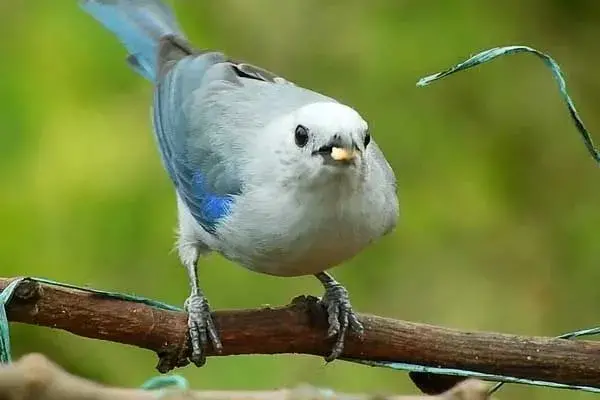
Scientific name: Thraupis episcopus
Lifespan: up to 12 years
Wingspan: n/a
Plumage Color: Bright blue on the wings and tail, light gray and white under
Native to: Mexico, Central, and South America
The blue-gray tanager is a medium-sized South American songbird found in open fields, towns, villages, and gardens in tropical and subtropical regions. They are native to Central Mexico, the Brazilian Amazon, and the islands of Trinidad and Tobago; blue-gray tanagers have been also introduced to Florida.
They have bright blue colors on the wings and tails, light blue, gray, and white underparts, and dark eyes and legs. Males and females look the same; these birds are not sexually dimorphic.
Blue-gray tanagers are very active and territorial animals that can be aggressive toward each other and other species of birds. They are omnivores that feed on fruit and insects.
Blue-grays have been also known to use and modify nests of larger birds or simply steal nests from smaller ones.
Blue-and-white Kingfisher
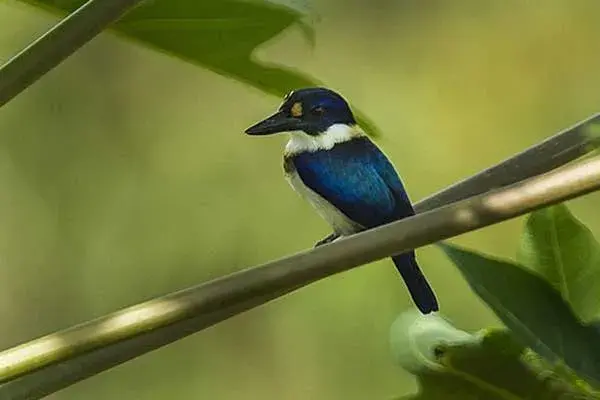
Scientific name: Todiramphus diops
Lifespan: n/a
Wingspan: n/a
Plumage Color: Bright azure-blue above and white underneath
Native to: Asia
The blue-and-white kingfisher is a small kingfisher with bright azure-blue upperparts and a gleaming white underside. Its natural habitat is the subtropical and tropical mangrove forests of Indonesia.
It is an insectivore that loves to feed on grasshoppers.
Collared Kingfisher

Scientific name: Todiramphus chloris
Lifespan: 11 years
Wingspan: 13 in
Plumage Color: Turquoise blue head and wings, and white chest
Native to: Asia and Australia
The collared kingfisher, also known as White-collared Kingfisher or Mangrove Kingfisher, is a medium-sized kingfisher with a large, black kookaburra-like beak.
White-collared kingfishers have a turquoise head and wing color, a white collar, and chest feathers. The feet are black. Males tend to have a slightly more blue tint, while females have a slightly more greenish.
These birds take care of their personal hygiene and will often take baths by jumping into the nearby rivers or lakes. After that, they can be seen drying and preening their feathers in bright sunlight.
Collared kingfishers are carnivores that feed on insects, crustaceans, small snakes, small birds, small fish, and even mice.
Woodland Kingfisher

Scientific name: Halcyon senegalensis
Lifespan: n/a
Wingspan: n/a
Plumage Color: Blue-colored back, wings, and tail, and white head and neck
Native to: Africa
The woodland kingfisher, the third kingfisher on our list of blue and white birds, is a medium-sized bird found in Africa south of the Sahara.
It has a bright blue back, wings, and tail. The head, neck, and underparts are white, while the shoulders are black. They have large red and black beaks.
Woodland kingfishers are often solitary birds that occasionally live in smaller groups. Territorial and aggressive, they will attack other birds and even humans.
Woodland kingfishers are carnivores that feed on large insects, snakes, fish, and frogs. They will rarely dive to catch their prey; an uncommon behavior for a kingfisher.
Tree Swallow
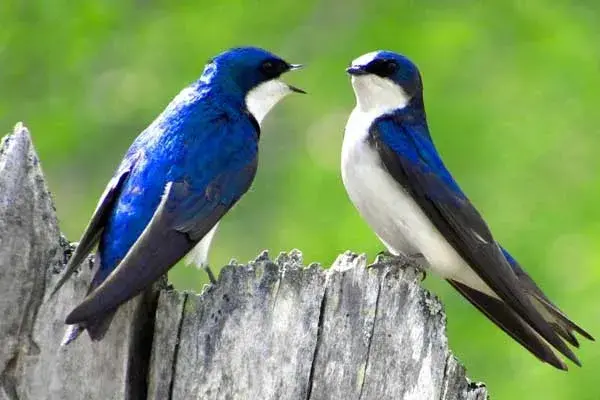
Scientific name: Tachycineta bicolor
Lifespan: 3 years
Wingspan: 12-14 in
Plumage Color: Blue above and white below with black feathers
Native to: the US and Canada
Tree swallows are small migratory songbirds with long, pointed wings and short, squared, or slightly notched tails. These birds have almost metallic greenish-blue backs and heads, together with white throats, breasts, and bellies.
Tree swallows breed in the United States and Canada – they begin migrating south in July and August to western Mexico and Central America.
They are social animals with flocks including thousands of birds. Tree swallows are omnivores that feed on insects, mollusks, spiders, and occasionally on fruit, berries, and seeds.
They are found in Florida, Tennessee, Kansas, Missouri, Ohio, and Pennsylvania.
Blue Winged Kookaburra

Scientific name: Dacelo leachii
Lifespan: 20 years
Wingspan: 25 in
Plumage Color: Brown, metallic blue, and cream white
Native to: Australia
The blue-winged kookaburra is a very large bird found in tropical and subtropical open woodlands, paperbark swamps, and farmlands of northern Australia and southern New Guinea.
It has a white head with brown streaks, sky blue shoulders, and white throat and underparts. It is also easy to identify by its big square head, long bill, and distinctive pale eyes.
This bird is famous for its hobby – hunting snakes. The blue-winged kookaburra will grab the reptile behind the head and smash it against a branch or a rock.
Blue-winged Kookaburras will lay white and shiny eggs, and sometimes, in the first week of being born, Blue-winged kookaburra chicks might aggressively kill their youngest sibling.
Eastern Bluebird

Scientific name: Sialia sialis
Lifespan: 6-10 years
Wingspan: 9-12 in
Plumage Color: Vivid blue above and brown and white on the throat and breast
Native to: North America
The eastern bluebird is a small North American migratory thrush with a big, rounded head, large eyes, and alert posture.
Marvelous birds to capture in your binoculars, male Eastern bluebirds have vivid royal blue plumage and warm red-brown and white breasts. It is the most widespread of the three bluebirds and can be found in the open country with scattered trees, farms, and roadsides in eastern parts of North America.
Just like its cousin, the mountain bluebird, the eastern bluebird is a cavity nester that loves nest boxes. It is a very social animal living in flocks including over 100 individuals. They are also very territorial animals.
To attract a female, a male bluebird will sing over 1,000 songs per hour; it sings without opening its beak wide.
The Eastern bluebird is the official bird of Missouri and New York. It is also very common in Pennsylvania and Maryland.
Budgie
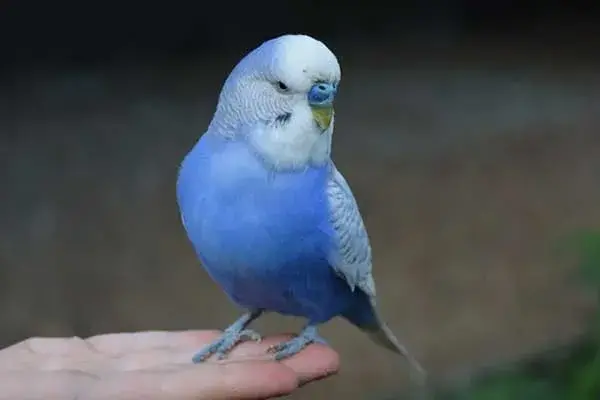
Scientific name: Melopsittacus undulatus
Lifespan: 3-6 years
Wingspan: 12 in
Plumage Color: Navy blue with a white head
Native to: Australia
The budgerigar, also called the common parakeet, is a small seed-eating parrot with a long tail. The bird is nicknamed the budgie. It is the third most popular pet in the world, right behind dogs and cats.
The budgie comes in many shapes and colors; one of them is a sky blue budgie that has a light, sky blue coloration, bright purple patches on its cheeks, and dark blue tail feathers.
Budgies have a third eyelid, just like camels or llamas. They are very intelligent birds that can count up to three and even learn a few words.
When the breeding season comes, female budgies can gain significant weight, up to 20% more than their usual weight. This is because they retain calcium during that period.
Guess I’m not overweight, I just retain calcium, just like the budgies, ha-ha.
Bali Myna

Scientific name: Leucopsar rothschildi
Lifespan: 5-15 years
Wingspan: 5 in
Plumage Color: White, with black bands on the wings and tail, and a blue patch around the eyes
Native to: Indonesia
The Bali myna is a beautiful, snow-white bird with black tips on its wing and tail feathers and striking sky-blue patches of skin around the eyes. Despite only having very little blue on its plumage, this mysterious bird still belongs to our list of blue and white-colored birds.
Bali mynahs are critically endangered animals with less than 100 adults assumed to exist in the wild. They were discovered in 1910 and became the faunal emblem of Bali, the famous Indonesian island.
Blue-and-white Flycatcher
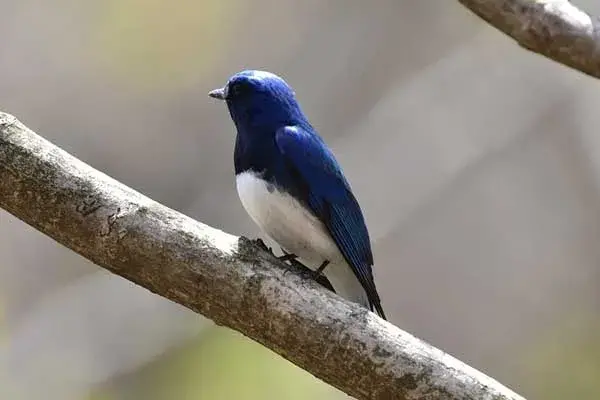
Scientific name: Cyanoptila cyanomelana
Lifespan: n/a
Wingspan: 10 in
Plumage Color: Royal blue upperparts, white belly, and black face, throat, and breast
Native to: Asia
The blue-and-white flycatcher is a beautiful songbird with royal blue upperparts, a white belly, and a black face, throat, and breast. It can be found in wooded areas in lowlands and submontane forests, parks, and gardens.
Blue-and-white flycatcher breeds in Japan, Korea, and parts of China and Russia.
It is an active territorial bird and an omnivore that feeds on berries, insects, and larvae, including beetles, moths, and bees.
Indian Paradise Flycatcher

Scientific name: Terpsiphone paradisi
Lifespan: n/a
Wingspan: 3.5 in
Plumage Color: White with dark blue head
Native to: Asia
The Indian paradise flycatcher is one of the most beautiful birds in the world thanks to its unique and long tail feathers. These birds come in 2 colors; one of them includes white plumage, a glossy dark blue crown and crest, and a blue ring around the eyes. The other color is cinnamon.
They are very noisy birds that make sharp skreak calls. Indian paradise flycatchers are monogamous birds that mate for life and both male and female birds help with building a nest.
They are insectivores that feed on dragonflies, moths, beetles, winged termites, ants, grasshoppers, and others.
California Scrub-Jay
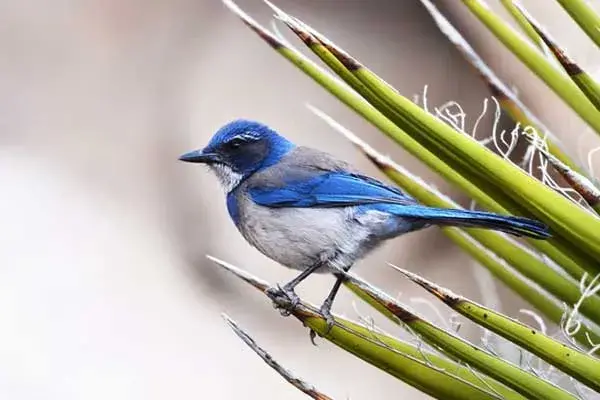
Scientific name: Aphelocoma californica
Lifespan: 9 years
Wingspan: 15 in
Plumage Color: Deep azure blue upperparts and white soft gray-brown underparts
Native to: western North America
California scrub jay is an attractive jay found in parks, neighborhoods, and riverside woods near the Pacific Coast. It is a medium-sized blue bird with deep azure blue plumage and white and soft gray-brown underparts.
These birds work with other animals and can be often seen on the backs of mule deer eating ticks and other parasites.
California scrub-Jays can be often seen stealing acorns from acorn woodpeckers or other jays. When they go to hide their own acorn, California scrub-jays will check first that no other jays are watching.
They are omnivores feeding on insects, fruit, nuts, seeds, and some small animals such as lizards and nesting birds.
They also have a thin line above their eyes that is called a supercilium. Read more about it and other birds that have it here.
Black-throated Blue Warbler
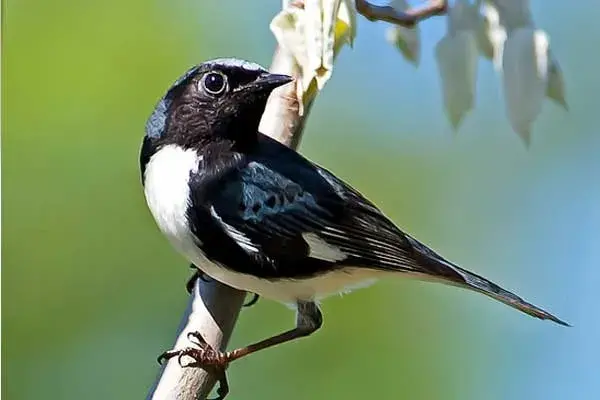
Scientific name: Setophaga caerulescens
Lifespan: up to 10 years
Wingspan: 7.5 in
Plumage Color: Midnight blue above and white below with some black parts
Native to: USA and Canada
Black-throated blue warbler is a small, well-proportioned bird with a sharp, pointed beak. It breeds in dense hardwood forests of the northeastern United States and eastern Canada.
Males have a deep midnight blue color above, white bellies, and black faces and sides. They do not change their appearance as the season changes; black-throated blue warblers can be easily recognized in the fall and in the spring.
When first discovered, since males and females look so different, people used to describe them as two separate species.
Black-throated blue warblers are cute-looking and very small songbirds weighing just 0.34 oz.
White-breasted Nuthatch
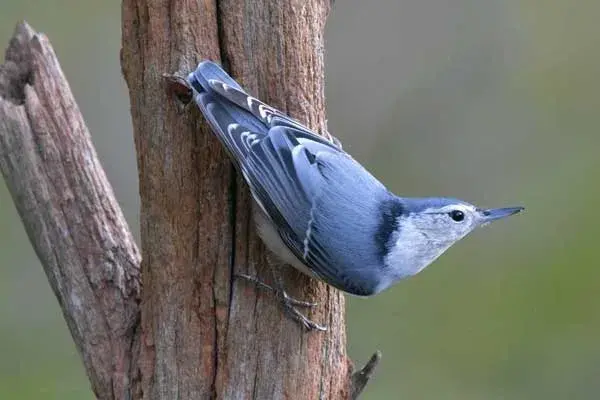
Scientific name: Sitta carolinensis
Lifespan: 2 years
Wingspan: 11 in
Plumage Color: Gray-blue on the back, and white on the face and underparts
Native to: North America
The largest nuthatch in North America, the white-breasted nuthatch is a medium-sized bird with clean blue-gray and white plumage. The male and female look very much alike, the only difference is that the female has lighter color.
These quirky and loud birds got their name from the way they crack open seeds – they will jam their seeds and nuts into tree bark, and then whack it with their beak to open them.
White-breasted nuthatches are blue birds found in forests and open areas of Pennsylvania, most of the United States, and parts of Canada and Mexico. They are omnivores that feed on insects and seeds.
Fischer’s Lovebird

Scientific name: Agapornis fischeri
Lifespan: 12-15 years
Wingspan: 3.5 in
Plumage Color: Bright blue back, tail, and chest, a white neck, and a pale brown-grey head
Native to: Africa
Fischer’s lovebird, a small parrot, was discovered in the 19th century. This gentle bird is very energetic and a loyal friend if treated well and interacted with regularly.
They are usually green, but there are several color variations. The most popular color variation of Fischer’s lovebirds is the blue one – the back, tail, and chest are bright blue, the neck is white, the head is pale brown-gray, and the beak is pale pink.
Males and females almost look identical; it is impossible to tell whether an individual is male or female through plumage alone.
Not recommended to everyone as pets, the Fisher’s lovebirds are famous for their mischievous and inquisitive nature. Back In 1987, Fischer’s lovebird was the most commonly traded bird in the world.
Want to read more about birds in Eastern Tennessee? Check this article.
Masked Lovebird

Scientific name: Agapornis personatus
Lifespan: 10-20 years
Wingspan: 3.5-4 in
Plumage Color: Blue body, rump, and tail, and a white collar
Native to: Africa
The Yellow-collared lovebird, also called the masked lovebird, is another example of conspicuous blue and white birds.
This parrot species comes in several colors. The blue masked lovebird has a black mask, pink beak, a white collar, and a deep blue body, rump, and tail.
This colorful lovebird of the East African savanna can be also found in woodlands, cultivated areas, and around human habitation. These birds mate for life and males and females look very similar.
When the breeding season comes, males become more agitated, while females build nests to rear young. The appetite of both increases during this time; the males will bring food, feed their partner, and they might preen one another (straighten and clean feathers with their beaks).
Read More: 15+ stunningly large blue birds
White-necked Jacobin
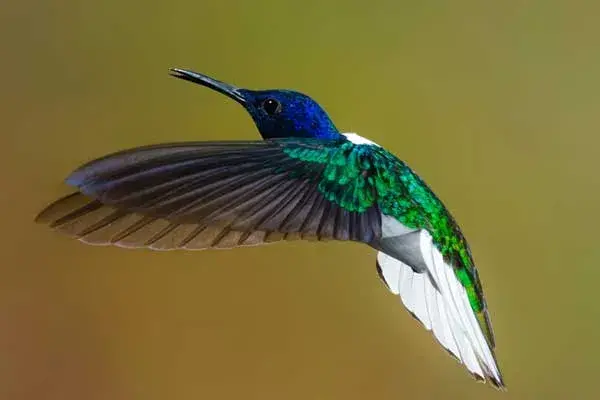
Scientific name: Florisuga mellivora
Lifespan: n/a
Wingspan: n/a
Plumage Color: Bright green upper plumage, a blue head and chest, and white abdomen and tail
Native to: Mexico, Central, and South America
A rather large hummingbird that ranges from Mexico south through Central America and northern South America, the white-necked Jacobin is a beautiful bird also known as the great Jacobin and the collared hummingbird.
These birds have bright green upper plumage, blue heads, and blue chests. Their abdomens and tails are white. White-necked Jacobins also have white bands on their napes (back of the neck) and dark blue hoods.
They are solitary birds that only get together to breed. Males will mate with several females; females will do the same with several males. To seduce females, males will fly in a u-shaped pattern in front of them.
White-necked Jacobins are omnivores that feed on small insects, and nectar from the flowers of tall trees, epiphytes, shrubs, and Heliconia plants.
Read More: 25+ incredible blue and orange birds
White-throated Magpie-jay

Scientific name: Calocitta formosa
Lifespan: 15-25 years
Wingspan: 7 in
Plumage Color: Bright blue and white
Native to: Mexico and Central America
Large, noisy, and gregarious, the white-throated magpie-jay is often found in areas of mixed grassland and woodland, around places that are under cultivation and along forest edges.
White-throated magpie-jays are blue and white birds whose breasts, bellies, and undersides are white, while the wings, mantles, and tails are blue.
They are omnivores that mostly feed on caterpillars and small fruits.
White-throated Magpie-Jays live in territorial social groups that typically consist of five to six adults.
Being so big, handsome, active, and noisy, the Magpie-Jays are sure to attract attention and make their presence known.
Read More: Examples of birds that have the blue color of their head plumage
Final Thoughts
If you happened to spot some bird with blue and white plumage, we hope this article helped you recognize it.
There are plenty of blue and white birds including blue jay, mountain bluebird, blue-and-white flycatcher, blue and white kingfisher, Florida scrub-jay, and many many others.
We hope you’ve enjoyed our list of 20+ birds with blue and white plumage, and that next time, should you meet any of these in the wild, you will have no problem identifying the species you saw.
And if you want to learn more about birds, feel free to check our popular read on black birds that have white spots on their feathers or a list of small blue-colored birds.